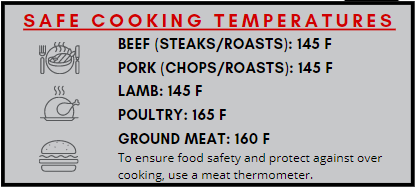How to make a great tasting steak (or pork or lamb chop):
- Start with an animal genetically inclined to produce a high-quality product.
Genetics + Environment = Phenotype
Basically, the genetic background of the animal, plus the environment it is raised in determines its physical appearance, or phenotype. Meat quality and quantity is a portion of that phenotype.
Utilizing genetic data, farmers and ranchers can select for specific quality traits for their livestock. For example, using ultrasound, measurements of a bull’s ribeye can be taken to estimate its size and marbling score. Knowing these numbers can provide an estimate of what the offspring will look like and be able to produce.
2. Feed the animal correctly to let it reach its maximum genetic potential.
The environment portion of the equation can consist of the animal’s surroundings, diet and lifestyle. In order to best maximize final product quality, animals need to be fed a high energy diet. Doing so will allow the animal to meet its full genetic potential.
For example, say twin steers each were fed different diets. One of them was fed a low energy, forage (ex. grass) based diet, while the other was transitioned to a high energy, grain (ex. corn) based diet. Both animals have the same genetic background, but their environment can have a major impact on the final product. Likely, the steer fed the high energy diet will produce a ribeye that has more intramuscular fat (marbling), which is associated with a higher quality product.
3. Keep the animal stress free and comfortable.
Stress can have a major negative impact on final product quality. Stressed animals can produce product that has color defects, limited ability to retain moisture, and tenderness problems. All these things can devalue the product, hurting the bottom line of the producer and the processor.
4. Harvest the animal efficiently.
Effectively rendering the animal unconscious and correctly exsanguinating it are imperative for maintaining product quality as well as ensuring humane handling. If the animal is not exsanguinated quickly and effectively, an increase in blood pressure can cause the capillaries within the muscle to burst, leading to splashes of blood within the meat. Not only is this unsightly to the consumer, but it also can poorly impact taste and can shorten shelf life.
5. Age the meat to allow time for natural tenderization to occur.
Storing the meat in a refrigerated environment for a period of time prior to cutting retail cuts allows natural enzymes found within the meat to breakdown protein and improve tenderness. Optimally, beef is aged for approximately 14 days, but can vary due to cut, demand, and storage space at the processing facility.
6. Cut steaks and keep them free from contamination that could impact taste and safety.
Meat can pick up contamination on surfaces as well as absorb off odors and flavors. Because of this, it is necessary to keep the environment clean and controlled. Contaminants can impact taste but can also be a food safety concern.
7. Package and store correctly.
Poor packaging and storage can lead to meat that can quickly develop off flavors or become rancid. Oxygen and light exposure can impact the color and flavor of meat products. Storing cuts in packaging that limits exposure to both is important to maintain a high-quality product. Additionally, keeping meat frozen and only thawing it as you need it is also a great way to keep quality and safety in check. For the best, safest eating experience, plan and thaw meat products in the fridge rather than on the counter or in the microwave.

8. Don’t overcook it!
Undercooking meat products is a food safety concern; however, overcooking them can lead to a product that is tough and dry. Using a meat thermometer is your best bet for a safe, high quality eating experience.
Who would have thought something as seemingly simple as a steak could be so complex? All these steps can add up to create a great tasting product. Similarly, an error at any point can hurt the final product (ex. great quality product that gets forgotten on the grill and is overcooked). One of the exciting things about careers in meat science is that we are constantly studying ways at every point throughout this process to try to improve the final product. We want to ensure a great eating experience every time that product is consumed!

